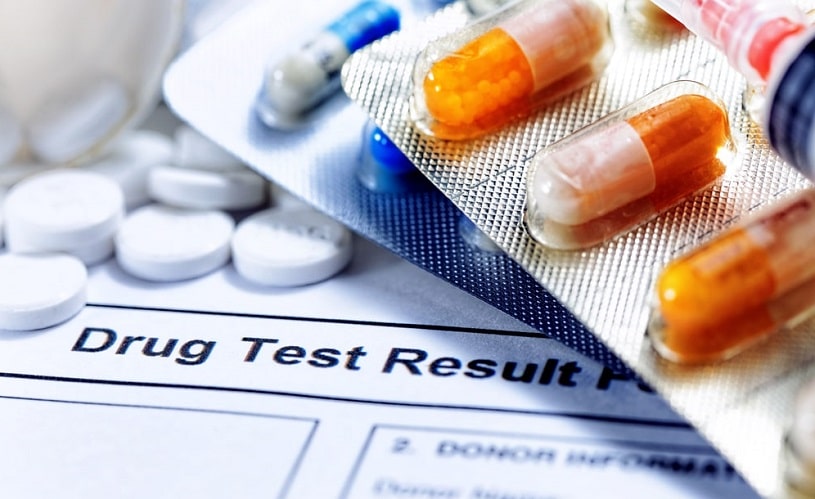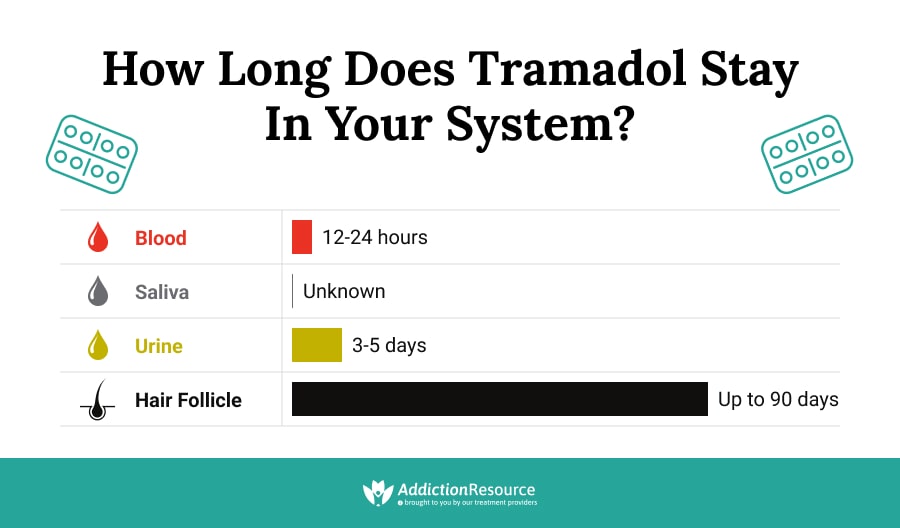Tramadol (also sold under the brand name Ultram) is a centrally-acting opioid analgesic used in the treatment of health conditions like moderate to severe pain or chronic pain that does not respond to treatment with weaker painkillers. The Tramadol half-life is about 6 hours in healthy individuals.
Table Of Contents:
However, the elimination time may depend on several factors beyond the Tramadol half-life. These factors include the dose, the individual’s health status, the concomitant use of other drugs, and other potential treatments affecting its metabolism. So, how long does Tramadol stay in your system and how long it will remain detectable by drug tests?
Tramadol Mechanism of Action
The Tramadol mechanism of action is explained by its effects as a centrally-acting analgesic that works through various mechanisms. The Tramadol mechanism of action works in the way that the drug causes pain relief through adrenergic and serotonergic activity, while the active metabolite O-desmethyltramadol acts on μ-opioid receptors. This is an important factor when explaining the Tramadol mechanism of action, its use in the treatment of pain, and how the drug may lead to opioid addiction. The cumulative effect of these is an analgesic potency which is considered one-tenth of that of morphine.
How Long Does It Take for Tramadol to Work?
The Tramadol onset of action usually takes between 30-60 minutes for the drug effects to be noticed significantly. However, the Tramadol onset of action can be delayed in treatment using extended-release tablets.
How Long Will the Effects Last?
This question is closely linked with the question of “how long does Tramadol stay in your system?”. Ultram effects can last for as long as 4-6 hours after ingestion of immediate-release formulations. Extended-release tablets are broken down more slowly by the body. It takes longer for their effects to be noticed, but the analgesic effects of extended-release formulations during treatment can last for as long as 12-24 hours.
How Is the Medication Metabolized?
After the patient takes it by mouth, the opioid is metabolized in two ways. First, the liver enzymes convert it into O-desmethyltramadol and N-desmethyltramadol. Then, the remaining drug and the metabolites are further metabolized by a pathway called conjugation. Notably, O-desmethyltramadol is biologically active. Thus, it can produce effects similar to that of the unchanged drug.
Tramadol Half-Life
How long does Tramadol stay in your system? The average elimination half-life is about 6 hours in healthy individuals, which is the amount of time it takes for half of the initial dose to be removed from the body. The half-life of Tramadol is important because it determines how often the drug will be taken and can be an essential factor when considering just how fast the drug will be eliminated after ingestion.

However, certain factors affect the half-life of Tramadol, such as the dose taken, liver health, chronic alcohol abuse, kidney health, advanced age, chronic use or addiction, and so on. For example, poor renal function can effectively double the half-life of Tramadol within the body.
How Long Does Tramadol Stay in Your System?
In an attempt to find an answer to this question, various tests were carried out on different body tissues. The opioid can stay within the system for up to months after the last dose. It may remain in one’s blood in a detectable amount for up to one day. Likewise, the urine and hair samples may contain it for up to 5 days and 90 days, respectively. In any case, various other factors also influence it.
Every individual has a unique ability to digest, metabolize and excrete the drug.
Besides, other drug factors further complicate the situation. They include doses, drug preparations, chronic use or addiction, and simultaneous use of other medications.
Thus, tracking the effect of every variable and determining the time for each is seemingly impossible. Nonetheless, specific standards help to interpret the test results.
Detection Window: What It Means For Drug Tests
A “window of detection” refers to the period of time during which a sample has enough drug (or metabolites) to fall within the cut-off range. Users should understand that a negative result does not mean they have not taken the medication. Instead, it means the amount present in the sample is lower than the cut-off value. With a positive test, one will need to have a confirmatory test, though a negative result requires no further tests. Experts say a positive Tramadol drug test indicates drug use within the previous three days.
Tramadol Urine Testing
The window of detection with a Tramadol drug test, when checking the urine, is 3-5 days. Meaning, if someone takes a tablet today and tests within 3-5 days, the amount present in the urine test may be well above the cut-off range.

The urine sample has approximately 30% of the original drug, while the metabolites contribute about 60% of the total excreted drug. Put simply, if an individual takes a 100 mg dose, 30 mg will be present in the urine as the drug itself. The test determines the presence of both the parent drug and metabolites.
Tramadol Blood Testing
Blood testing is a Tramadol drug test but is not as common as the urine test. For the most part, it is because drawing the blood sample is an invasive procedure. Yet, some hospitals may use a blood test to help measure the patient’s response. Moreover, scientists may also draw the blood sample for research purposes.
The detection window using the blood sample may be 12-24 hours. Studies have found that sustained-release tablets can reach a peak concentration 4.9 hours after one takes them.
Tramadol Hair Testing
Typically, the drug’s standard detection window using a hair Tramadol drug test is 10-90 days. However, deviations in the timeframe are entirely possible. Note that the hair can retain it for a longer time in comparison with the urine or blood sample.

Factors That Influence the Detection Window
The length of time the medicine stays in the system may not correspond to the test results. That said, one may have it in the blood or urine and still get a negative result; when the amount in the sample lies below the cut-off level. Another determinant of the test result is the sensitivity of the procedure that the person uses. Understandably, the test with a higher sensitivity detects even a slight amount in the sample.
Several important factors may influence the length of time the medication can remain detectable within the system.
They Include:
- Age: A study has shown that individuals over 75 have a longer Tramadol half-life than their younger counterparts. It means that Tramadol half-life in this age group is 7 hours as opposed to the 5-6 hours seen in healthy, younger individuals.
- Sex: Due to several physiological differences between men and women, the half-life of Tramadol may be higher in women.
- Liver function: Individuals with poor liver function, for example, due to chronic alcohol abuse, cannot properly metabolize the medication and its metabolites, leading to them accumulating within the body in higher concentrations and persisting for longer than average.
- Kidney function: Since the kidneys are the major excretory organ of the body, kidney dysfunction prevents the proper excretion of the substance and its active metabolites, effectively increasing their half-lives to as much as 10 hours.
- Dose of medication taken: The dose taken also has a significant effect on the half-life of the opioid. In the event of an overdose on Tramadol, the half-life can exceed 9 hours.
- Liver enzymes: The medication is metabolized by cytochrome P450 enzymes. These enzymes' activity can be altered by various substances such as drugs, alcohol, poisons, and so on.
- Formulation taken: Extended-release capsules last longer within the body than immediate-release formulations.
- Duration of use: Chronic use of the opioid causes the medication to build up within the body, which means it'll take longer to completely rid yourself of the drug, as seen in those who take it for chronic pain or drug addiction.
- Concomitant use with other medications: Several drugs can alter the medication's metabolism, thereby increasing its half-life. Some examples include quinidine, alcohol, amitriptyline, and fluoxetine.
Dealing With an Opioid Addiction
Tramadol is an opioid analgesic with significant potential to cause dependence. Those who want to get it out of their system should know that abrupt cessation may be accompanied by symptoms of withdrawal. It is not advised to quit it cold-turkey, but rather taper off under the doctor’s supervision. The unpleasant withdrawal symptoms and the chance of relapsing are the reason why seeking professional help at a drug rehabilitation center is necessary. They can provide you with the medical expertise, social support, and realistic coping techniques you need to help rid yourself of opioid addiction.
Hope Without Commitment
Find the best treatment options. Call our free and confidential helpline
Most private insurances accepted
Page Sources
- Sebastián Videla, Mounia Lahjou, Anna Vaqué, Mariano Sust, Marisol Escriche, Lluis Soler, Artur Sans, Eric Sicard, Neus Gascón, Gregorio Encina, Carlos Plata‐Salamán. Pharmacokinetics of multiple doses of co‐crystal of tramadol–celecoxib: findings from a four‐way randomized open‐label phase I clinical trial. Br J Clin Pharmacol. 2018 Jan; 84(1): 64–78. https://www.ncbi.nlm.nih.gov/pmc/articles/PMC5736845/
- Hamid Khosrojerdi, Ghazal Alipour Talesh, Gholam Hassan Danaei, Sara Shokooh Saremi, Afrouz Adab, Reza Afshari. Tramadol half life is dose dependent in overdose. Daru. 2015; https://www.ncbi.nlm.nih.gov/pmc/articles/PMC4348403/
- Forensic Science International 135 (2003) 129–136. Determination of tramadol in hair using solid phase extraction and GC–MS. Kamal A. Hadidia, Jamal K. Almasadb, Thair Al-Nsourc, Samih Abu-Ragheiba. 2003. http://samih-abualraghib.com/Determination%20of%20tramadol.pdf
- Sarbu, A., Radulescu, F., Robertson, S., & Bouchard, S. (2008). Onset of analgesic effect and plasma levels of controlled-release tramadol (Tramadol Contramid once-a-day) 200-mg tablets in patients with acute low back pain. Journal of opioid management, 4(5), 285–292. https://doi.org/10.5055/jom.2008.0032 https://pubmed.ncbi.nlm.nih.gov/19070266/
- Dayer, P., Desmeules, J., & Collart, L. (1997). Pharmacologie du tramadol [Pharmacology of tramadol]. Drugs, 53 Suppl 2, 18–24. https://doi.org/10.2165/00003495-199700532-00006
- World Health Organization. Tramadol Update Review Report. 2014. https://www.who.int/medicines/areas/quality_safety/6_1_Update.pdf
- Bertilsson, L., Dahl, M. L., Dalén, P., & Al-Shurbaji, A. (2002). Molecular genetics of CYP2D6: clinical relevance with focus on psychotropic drugs. British journal of clinical pharmacology, 53(2), 111–122. https://doi.org/10.1046/j.0306-5251.2001.01548.x
- Khosrojerdi, H., Alipour Talesh, G., Danaei, G. H., Shokooh Saremi, S., Adab, A., & Afshari, R. (2015). Tramadol half life is dose dependent in overdose. Daru : journal of Faculty of Pharmacy, Tehran University of Medical Sciences, 23(1), 22. https://doi.org/10.1186/s40199-015-0104-y
- National Health Service. Tramadol. 2018 https://www.nhs.uk/medicines/tramadol/
- Pham, P. C., Toscano, E., Pham, P. M., Pham, P. A., Pham, S. V., & Pham, P. T. (2009). Pain management in patients with chronic kidney disease. NDT plus, 2(2), 111–118. https://doi.org/10.1093/ndtplus/sfp001
- Chiara Angeletti, Cristiana Guetti, Antonella Paladini, & Giustino Varrassi (2013). Tramadol Extended-Release for the Management of Pain due to Osteoarthritis. Volume 2013, Article ID 245346, 16 pages http://dx.doi.org/10.1155/2013/245346
- Chandok, N., & Watt, K. D. (2010). Pain management in the cirrhotic patient: the clinical challenge. Mayo Clinic proceedings, 85(5), 451–458. https://doi.org/10.4065/mcp.2009.0534
- Pham, P. C., Toscano, E., Pham, P. M., Pham, P. A., Pham, S. V., & Pham, P. T. (2009). Pain management in patients with chronic kidney disease. NDT plus, 2(2), 111–118. https://doi.org/10.1093/ndtplus/sfp001
- Khosrojerdi, H., Alipour Talesh, G., Danaei, G. H., Shokooh Saremi, S., Adab, A., & Afshari, R. (2015). Tramadol half life is dose dependent in overdose. Daru : journal of Faculty of Pharmacy, Tehran University of Medical Sciences, 23(1), 22. https://doi.org/10.1186/s40199-015-0104-y

 Authored by
Authored by  Reviewed by
Reviewed by 

